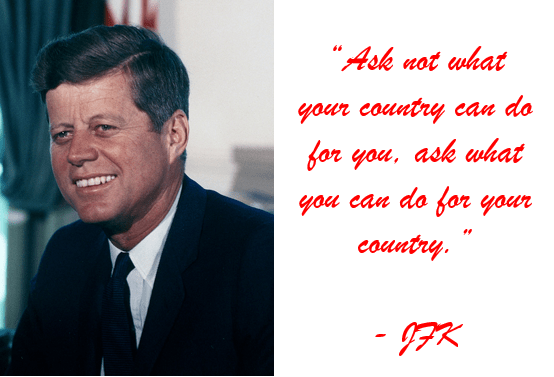
Contrary to popular belief, charisma isn’t something that you either have, or you don’t.
It’s a myth that charisma is a magical quality, or a gift from the gods, that some lucky individuals are just born with. Science has shown that becoming more charismatic is about adopting charismatic behaviors. This means that anyone can learn how to “light up a room”, boost their X-factor, and have that “it” quality.
 Why would you want to become more charismatic? Because charisma can help you with all of the following:
Why would you want to become more charismatic? Because charisma can help you with all of the following:
- Be more successful at work;
- Be a more effective and respected leader;
- Become a better salesperson;
- Attract a love interest;
- Get your message through to others–your students, your colleagues, your company’s board of directors, the neighborhood association, etc.;
- Win political office; and so on.
Boosting your charisma will help you in just about any life situation. After all, attraction is a powerful tool. It can help you to get what you want without having to resort to either coercion (stick) or payment (carrot). Below you’ll find 20 brilliant ways to skyrocket your charisma.
1. Be Present. Olivia Fox Cabane is an executive coach to the leadership of Fortune 500 companies, assisting them in becoming more persuasive, influential and inspiring. She’s lectured at Stanford, Yale, Harvard, MIT, and the United Nations. In addition, she’s the author of The Charisma Myth: How Anyone Can Master the Art and Science of Personal Magnetism.
Cabane indicates that charisma determines whether people will “like you, trust you, and want to be led by you”. In her book, she explains that there are three pillars of a charismatic personality. These are: presence, power, and warmth. Let’s start with the first of these – presence.
Being present is about being fully in the moment. There’s something magnetic about someone who is giving all of their focus and attention to the here and now. On the other hand, it’s off-putting when you’re talking to someone and they seem distracted, like their mind is somewhere else.
To be more charismatic, focus your mental and emotional energy on the person that you’re talking to. In addition, ask clarifying questions; don’t interrupt them when they’re speaking: and listen to them fully, instead of thinking about what you’re going to say next.
2. Be Powerful. The second pillar of charisma identified by Cabane is being powerful. When others perceive you as someone who is powerful, it means that they think that you can make things happen. And that perception makes you charismatic.
Here are some things you can do in order to increase your charismatic power:
- Feel confident and powerful.
- Stand tall and hold your head up.
- Nod your head selectively when something important is brought up.
- Drop your pitch at the end of a sentence so that it sounds like you’re making an assertion, instead of raising the pitch at the end so that it sounds like you’re asking a question.
- Be knowledgeable – people who come off as being smart, also come off as being powerful.
3. Show Warmth. The third pillar of charisma, according to Cabane, is showing warmth. You transmit warmth to others when you make them feel like you care about them. That is, you make them feel like you genuinely like them.
This is hard to fake. In order to be able to show warmth toward others, you have to develop warmth within.
Right now you may be thinking: “But I’m not really a ‘people’ person. I don’t think I can be warm towards others”. The good news is that warmth can be developed. Here are some things you can do to develop warmth:
- Feel fellowship toward others; after all, we’re all on the same boat.
- Develop empathy –try to put yourself in the shoes of the other person and ask yourself what they may be feeling.
- Feel curious about other people. Why do they see the world the way do? What makes them tick?
- Tell yourself that there’s something that you really need to know, and that the person sitting in front of you has been sent to tell you what it is.
In order to convey warmth to others, do the following:
- In almost any situation, think of yourself as the host, and try to make others comfortable; put them at ease.
- Use your voice – speak in a soft, rich tone.
- Give sincere compliments.
- Use your eyes to transmit kindness; you can do this by softening your gaze.
To sum up Cabane’s recommendations on how to be more charismatic, she indicates that you should stare like a lover, stand like a gorilla, and speak like a preacher. What does this mean?
- You want deep, but warm eye contact.
- You want to stand in a way that broadcasts power and confidence.
- You want to speak in a slow, confident, resonant and warm voice.
One way to achieve this is to think of yourself as a preacher. You care about your congregation (warmth), you have confidence that the strength of God is with you (power), and you’re fully committed to your mission (presence).

(Photo Credit: Like a Lover; Like a Gorilla; Like the Dalai Lama)
4. Use Imagery. A lot of charisma is related to what you say, and how you say it. John Antonakis, Ph.D.,—a professor at the University of Lausanne in Switzerland who teaches people how to become more charismatic–explains that there are twelve charisma tactics that you can use to increase your charisma. Nine of those tactics are verbal, and three of them are nonverbal.
You can use these tactics in practically any situation:
- When you give a speech or a presentation;
- During meetings; and
- During one-on-one conversations.
In addition, you can use them both personally and professionally. Keep in mind that you don’t need to employ all of the tactics in every conversation; instead, use a balanced combination.
The first of the nine verbal tactics is using metaphors, similes, and analogies to help your listeners understand, relate to, and remember your message. Using imagery makes your message more vivid and interesting, which makes it more effective.
As an example, here’s something Fox Cabane said during a presentation about charisma:
“In controlled laboratory experiments, researchers were able to raise, or lower, people’s levels of charisma, as if they were turning a dial, just by instructing them to exhibit specific charismatic behaviors.”
You can immediately see yourself turning a dial—as you stand up straighter, soften your gaze, and put some enthusiasm in your voice—and gradually raising your charisma.
5. Tell Stories. The second verbal charisma tactic is to tell personal stories and anecdotes to make your message more engaging and to help your listeners connect with you. Charismatic people are good story tellers. You can use this tactic whether you’re at a cocktail party, chatting up a pretty girl at the gym, or running for president.
Someone who uses the tactic of story-telling often is President Obama. His speeches are often peppered heavily with stories and personal anecdotes. This makes the audience relate to what he’s saying and identify with him.
For example, when he called on parents to toughen up on their kids and exhort them to get good grades in school, he shared that this is what he did with his then eleven-year-old daughter, Malia. Here’s the story:
- Malia got a 73 on a science test.
- She was upset because her parents had always told her that the goal was to get 90 or above on any test.
- Obama sat down with Malia and they came up with a game plan on how she could do better the next time.
- And it worked. On her next science test, she got a 95.
Obama was telling the audience: “I encourage my kids to do well in school, and this is what I’m asking you to do, as well.”
6. Use Contrasts. The third verbal charisma tactic is to use contrasts to clarify your position by pitting it against the opposite. John F. Kennedy used contrasts when he said: “Ask not what your country can do for you, ask what you can do for your country.”

One way to use contrasts is to ask: do we want this (insert a negative), or do we want that (insert a positive). Here’s an example: Do we want to live in a world in which refugee toddlers wash up on the beach, or do we want to live in a world in which the international community gives refugees the safe harbor and aid they need?
7. Ask Rhetorical Questions. The fourth verbal charisma tactic is to ask rhetorical questions to encourage engagement. As with all the other charisma tactics, rhetorical questions work both in public and private settings. As an illustration, if you’re talking to a subordinate who is chronically late for work, you can ask him the following:
- Where do we go from here?
- Are you going to keep coming up with excuses to explain why you’re always late, or are you going to start taking steps to get here on time?
- Are you willing to become the type of employee this company can count on?
8. Use Three-Part Lists. The fifth verbal charisma tactic is to use three-part lists to distill your message into easy takeaways. Three is the magic number because most people can remember three things, three is enough to provide proof of a pattern, and three gives an impression of completeness.
If you think about it, you’ll notice that three-part lists can be found in everything from religion to politics. Here are three examples:
- Religion: Three Wise Men with their gold, frankincense, and myrrh.
- Movies: The Good, the Bad, and the Ugly
- The U.S. Declaration of Independence: “Life, liberty, and the pursuit of happiness”.
Here’s an illustration of using a three-part list in a speech: “Let’s think of what we did right, let’s think of what we did wrong, and let’s use what we learn from that analysis to get back on track.”
9. Use Expressions of Moral Conviction. The sixth verbal charisma tactic is to use expressions of moral conviction that reveal the quality of your character. People are moved by ideas and values. For example, when Obama was running for president he appealed to the electorate with a message of hope, a new beginning, and a new future.

As another example, Ruth Blatt, Ph.D., writes in her article “How to Increase Your Charisma” that rock stars often display moral conviction to strengthen their bond with their audience. She uses U2 as an illustration. During their 360-degree tour, the band had fans march around the stage with pictures of then-imprisoned Aung San Suu Kyi (a Burmese political prisoner).
10. Reflect Your Listener’s Sentiments. The seventh verbal charisma tactics is to reflect your listeners’ sentiments to make them identify and align themselves with you. To achieve this you can use statements such as the following:
- I know that you’re frustrated, so am I.
- I want things to change as much as you do.
11. Set High Goals. The eighth verbal charisma tactic is to set high goals. Antonakis writes in an article for the Harvard Business Review that Gandhi, an incredibly charismatic leader, used this tactic. Gandhi set the almost impossible goal of liberating India from British rule without using violence, as laid out in his famous “quit India” speech.
12. Convey Confidence that High Goals Can be Achieved. Once you set high goals, you have to convey confidence that those high goals can be achieved. This is the ninth verbal charisma tactic. Again, Antonakis cites Gandhi, who demonstrated that he was confident that India would “wrench her liberty with nonviolence from unwilling hands” when he said:
“I know the British Government will not be able to withhold freedom from us, when we have made enough self-sacrifice.”

13. Use Nonverbal Tactics. The three nonverbal charisma tactics that Antonakis recommends that you use in order to become more charismatic are:
- Using body gestures.
- Using facial expressions—being emotionally expressive.
- Keeping an animated voice.
Here’s how to apply these tactics:
- Punctuate your words with appropriate gestures.
- Express the emotion of your words consistently with your eyes and face.
- Vary the volume, tone, pacing, and pauses to emphasize your message.
Former President Bill Clinton is an expert at using nonverbal cues to wow an audience. In particular, he’s great at moving his hands in sync with what he’s saying. You can see how he does this in his DNC speech, below.
14. Remember People’s Names. When you remember someone’s name, it makes them feel important and respected. It fills that person’s desire for attention and love. One technique you can use is to look into the person’s eyes and repeat their name: “Hi Marcia, nice to meet you.”
Then, try to make a mental association that will help you remember the name. For example, “Marcia is from Maine, and she has long, blonde hair like Marcia from the Brady Bunch”.
15. Use Humor. Professor Joseph Nye of the Harvard Kennedy School explains that charisma is a sense of “personal magnetism”. He goes on to say that one way to make yourself more magnetic is to use humor. After all, as Herbert Gardner said, “Once you get people laughing, they’re listening and you can tell them almost anything.”
Nye indicates that Ronald Reagan—who ranks as the third most charismatic US president after Bill Clinton and John Kennedy—had an extraordinary ability to use humor to project warmth of personality.
As an example, on October 21, 1984, in the second presidential debate with candidate Walter Mondale, Reagan was grilled over his age by Henry Trewhitt of the Baltimore Sun. Here’s how Reagan answered:
“I want you to know that also I will not make age an issue of this campaign. I am not going to exploit, for political purposes, my opponent’s youth and inexperience.”
You can watch a montage of the famous Regan wit, below:
16. Be Energetic. Professor Alex Pentland from the Massachusetts Institute of Technology (MIT) studies social signals. Along with his team at MIT, he created a small device they call the “Sociometer”. The device—worn around the neck—is used to gauge a person’s charisma.
To do this, the Sociometer measures not what you say, but how you say it. “So the first thing is energy,” says Pentland in an interview on CBS. He explains that to be charismatic, you have to be energetic. Pentland goes on as follows:
“It shows up in your hands. It shows up in your voice, the way you carry yourself and do things.”
Pentland explains that one of the best predictors of whether an idea will be accepted by others is if the proponent of the idea sounds excited, and his speech is fluid. That is, you can predict how likely it is that an idea will be accepted–even if you don’t pay attention to the substance of what is being said–based on the way in which the speaker presents the idea.
17. Make Yourself More Attractive. Studies show that people who are rated as attractive are treated more favorably than unattractive people. This is even truer for women than for men. Look at the following:
- In an election, a handsome man holds an edge over an ugly rival that is worth 6 to 8% of the vote.
- The edge for an attractive woman is worth 10% of the vote.
While it’s true that you’re born with certain immutable physical traits, you can make yourself more attractive by being well groomed, wearing clothes that flatter your body type, and eating well and following a fitness routine.
In addition, being comfortable in your own skin will go a long way toward making you more attractive to others.
18. Master Emotional Control. Charismatic individuals have the ability to control and regulate their emotional displays. They can remain calm and collected even in times of crisis. If they get angry and show it, it’s always on purpose and to make a point. They’re good emotional actors, and they can turn on the charm when they want to.
19. Appeal To the Self-Interest of Others. Charisma, like beauty, is in the eye of the beholder. And one way to make others see you as being charismatic is to appeal to their self-interest. In other words, be curious about others and make them feel that their views and needs are important.
As an illustration, when Dr. Pentland, the MIT professor mentioned previously, was giving a presentation on charisma at the Boston Museum of Science, he started off by saying:
“Thank you all for coming, and I hope that we can get some things going that will benefit you”.
Basically, he was communicating the following message: “This speech isn’t about me and what I want; this speech is about making your life better”.
20. Be Positive. People who are always complaining, who criticize others, and who see everything as a problem are anything but charismatic. Charismatic people, on the other hand, have a positive, can-do attitude. They don’t over-dramatize, and they give the impression that they’re ready to take on whatever life throws at them.
Conclusion
Have you ever been in a meeting in which one person presented an idea but was met with a lukewarm response, and then a few minutes later someone else presented a very similar idea and was met with enthusiasm and applause?
If you have, then you’ve witnessed the difference between someone who lacks charisma and someone who has it in spades.
Wouldn’t you like to be more charismatic? I think we all do. You can get started with the 20 tips above. Live your best life by becoming more charismatic.





Related Posts:
- How to Develop Your Character – Benjamin Franklin’s Thirteen Virtues
- How to Make Decisions Like Benjamin Franklin
- What a Special Agent Can Teach You About Achieving Your Goals
- What A 16th Century Priest Can Teach You About Self-Improvement
Did you enjoy this article? Subscribe to “Daring to Live Fully” by RSS or by email, and get free updates.




 Marelisa Fabrega is a lawyer and entrepreneur. She holds a Bachelor of Science in Business Administration from Georgetown University in Washington, D.C., as well as a Juris Doctor from the Georgetown University Law Center. You can learn more about her
Marelisa Fabrega is a lawyer and entrepreneur. She holds a Bachelor of Science in Business Administration from Georgetown University in Washington, D.C., as well as a Juris Doctor from the Georgetown University Law Center. You can learn more about her 





